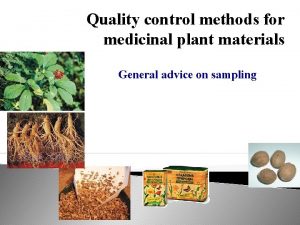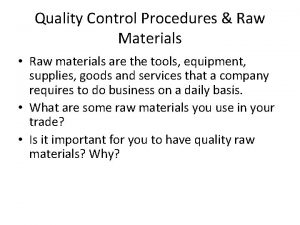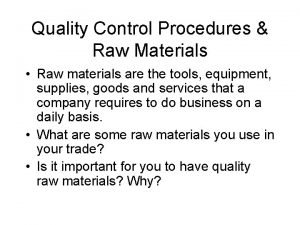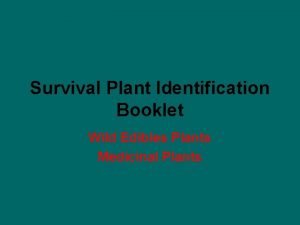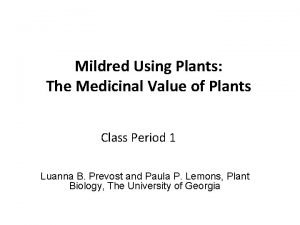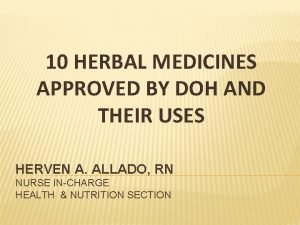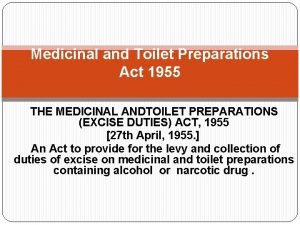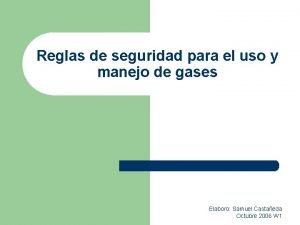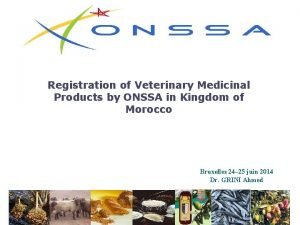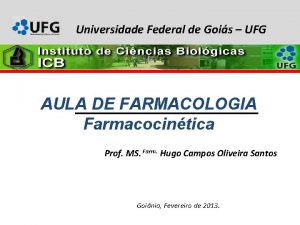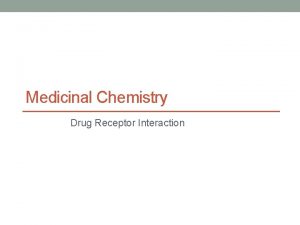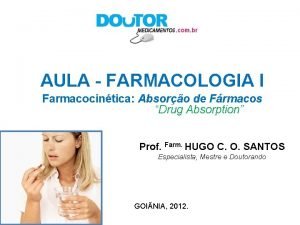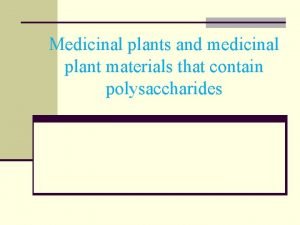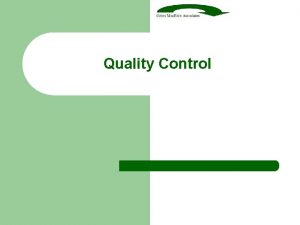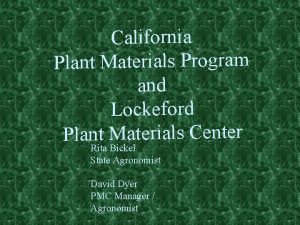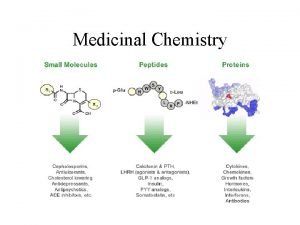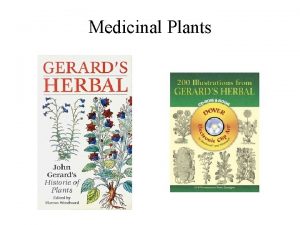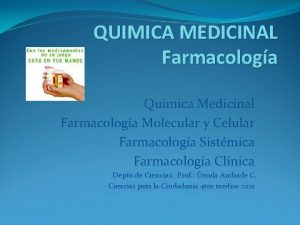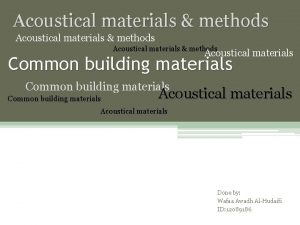Quality control methods for medicinal plant materials General























- Slides: 23

Quality control methods for medicinal plant materials General advice on sampling

Plan 1. 2. 3. 4. General recommendations for the sampling of pharmaceutical materials. Terms Sampling of the batches Sampling of the retail packages Foreign matters

Stages of quality determination for medicinal plant materials 1. Acceptance of batch 2. Sampling 3. Analysis of samples Batch is amount no less than 50 kg of one type of medicinal plant material, and drawn by one document confirmed its quality.

The reliability of any conclusions drawn from the analysis of a sample will depend upon how well the sample represents the whole batch. General recommendations for the sampling of pharmaceutical materials in connection with quality control are provided in the thirty-first report of the WHO Expert Committee on Specifications for Pharmaceutical Preparations. Thirty first report. Geneva, World Health Organization, 1990 (WHO Technical Report Series, No. 790) Annex 2, pp. 34 -47.

Because of the specific characteristics of medicinal plant materials, in particular their lack of homogeneity, special handling procedures are required in relation to sampling. The following procedures should be observed when selecting and preparing an average sample from a batch of material.

Sampling of material in bulk • Inspect each container or packaging unit for conformity with pharmacopoeia monographs or other requirements regarding packaging and labelling. Check the condition of the package and note any defects that may influence the quality or stability of the contents (physical damage, moisture, etc. ). • Sample damaged containers individually.

If initial inspection indicates that the batch is uniform, take samples as follows. batch sampling 1 -5 All units 6 -50 5 units over 50 10 %, rounding up the number of units to the nearest multiple of ten. For example, a batch of 51 units would be sampled as for 60, i. e. take samples from six packages.

After opening, inspect the contents of the units selected for sampling for: - organoleptic characteristics (colour, texture and odour); - presentation of the material (raw, cut, crushed, compressed); - the presence of admixtures, foreign matter (sand, glass particles, dirt), mould, or signs of decay; - the presence of insects; - the presence of packaging material originating from poor or degraded containers.

From each container or package selected, take three original samples, taking care to avoid fragmentation. Samples should be taken from the top, middle and bottom of the container. In the case of sacks and packages, the three samples should be taken by hand, the first from a depth of not less than 10 cm from the top and the second and third from the middle and bottom after cutting into the side of the package. Samples of seeds should be withdrawn with a grain probe. Material in boxes should first be sampled from the upper layer; then approximately half of the contents should be removed and a second sample taken. Finally after further removal of material, another sample should be taken from the bottom. Samples should be as uniform as possible in mass.

The three original samples should then be combined into a pooled sample which should be mixed carefully. The average sample is obtained by quartering. Form the pooled sample, adequately mixed, into an even and square-shaped heap, and divide it diagonally into four equal parts. Take two diagonally opposite parts and mix carefully. Repeat the process as necessary until the required quantity, to within ± 10%, is obtained (100200 g for flowers and up to 10 kg for certain roots). Any remaining material should be returned to the batch. Using the same quartering procedure, divide the average sample into four final samples, taking care that each portion is representative of the bulk material. The final samples are tested for the following characteristics: - degree of fragmentation (sieve test); - identity and level of impurities; - moisture and ash content; - level of active ingredients, where possible.

Sampling of the batch Units Samples from the top Samples from the middle Samples from the bottom A pooled sample Degree of fragmentation (sieve test); Identity and level of impurities (foreign matter) The average sample Moisture and Ash content; Level of active ingredients

Quartering procedure

Insect contamination (Sitophilus granarius) granary weever : 1 — beetle; 2 — larva; 3 — chrysalis (Acaridae) true mites (Tinea granella) European grain moth : 1 — butterfly; 2 — larva; 3 — chrysalis.

Sampling of material in retail packages From each wholesale container (boxes, cartons, etc. ) selected for sampling, take at random two consumer packages. From small batches (1 -5 boxes), take ten consumer packages. Prepare the pooled sample by mixing the contents of the selected consumer packages and proceed as described above to obtain the final sample.

Sampling of material in retail packages Unit 2 consumer packages Unit 2 consumer packages 2 consumer packages Pooled sample The final sample Identity; The final sample Moisture content Ash content The final sample Level of active ingredients The final sample Foreign matter

Determination of foreign matter Medicinal plant materials should be entirely free from visible signs of contamination by moulds or insects, and other animal contamination, including animal excreta. No abnormal odour, discoloration, slime or signs of deterioration should be detected. It is seldom possible to obtain marketed plant materials that are entirely free from some form of innocuous foreign matter. However, no poisonous, dangerous or otherwise harmful foreign matter or residue should be allowed. During storage, products should be kept in a clean and hygienic place, so that no contamination occurs. Special care should be taken to avoid formation of moulds, since they may produce aflatoxins. Macroscopic examination can conveniently be employed for determining the presence of foreign matter in whole or cut plant materials. However, microscopy is indispensable for powdered materials. Any soil, stones, sand, dust and other foreign inorganic matter must be removed before medicinal plant materials are cut or ground for testing.

Definition Foreign matter is material consisting of any or all of the following: - parts of the medicinal plant material or materials other than those named with the limits specified for the plant material concerned; - any organism, part or product of an organism, other than that named in the specification and description of the plant material concerned; - mineral admixtures not adhering to the medicinal plant materials, such as soil, stones, sand, and dust.

Sample size The following quantities constitute a sample, unless otherwise specified in the test procedure for the plant material concerned. Plant material Sample size roots, rhizomes and bark 500 g leaves, flowers, seeds and fruit 250 g cut medicinal plant materials (average weight of each fragment less than 0. 5 g) 50 g

Foreign matter in whole or cut medicinal plant materials Weigh a sample of plant material, taking the quantity indicated above unless other-wise specified in the test procedures for the plant material concerned. Spread it in a thin layer and sort the foreign matter into groups either by visual inspection, using a magnifying lens (6 x or 10 x), or with the help of a suitable sieve, according to the requirements for the specific plant material. Sift the remainder of the sample through a No. 250 sieve; dust is regarded as mineral admixture. Weigh the portions of this sorted foreign matter to within 0. 05 g. Calculate the content of each group in grams per 100 g of air-dried sample. For some medicinal plant materials where the foreign matter may closely resemble the material itself, it may be necessary to take a pooled sample of the plant material and apply a critical test, either chemical, physical or by microscopy. The proportion of foreign matter is calculated from the sum of the portions that fail to respond to the test.

Literature 1. 2. 3. 4. 5. 6. Pharmacognosy / ed. by prof. V. S. Kyslychenko Kharkiv/ NUPh, “Zoloti storinky”. – 2011. – 600 p. WHO Expert Committee on Specifications for Pharmaceutical Preparations. Thirty first report. Geneva, World Health Organization, 1990 (WHO Technical Report Series, No. 790) Annex 2, pp. 34 -47. Trease G. E. , Evans W. C. Pharmacognosy. - London; Philadelphia; Toronto: Sydney; Tokyo; WB Saunders, 1996. 832 s. British Herbal Pharmacopoeia / British Herbal Medicine Association. - London, 1996. – 212 p Практикум по фармакогнозии: учебное пособие для студ. вузов / под ред В. Н. Ковалева. – Х: Изд-во НФАУ, Золотые страницы, 2003. - 512 с.



 Quality control methods for medicinal plant materials
Quality control methods for medicinal plant materials Importance of aromatic plants
Importance of aromatic plants What is qc
What is qc Raw material receiving process
Raw material receiving process Quality control of raw materials
Quality control of raw materials Quality control and quality assurance
Quality control and quality assurance Quality control vs quality assurance pmp
Quality control vs quality assurance pmp Quality metrics pmp
Quality metrics pmp Concepts of quality
Concepts of quality Jewel weed medicinal
Jewel weed medicinal Objective of medicinal plants
Objective of medicinal plants Mixtures of organic substances and a medicinal agent are:
Mixtures of organic substances and a medicinal agent are: Medicinal chemistry lectures
Medicinal chemistry lectures Tsaang gubat benefit
Tsaang gubat benefit Patrick: an introduction to medicinal chemistry 3e
Patrick: an introduction to medicinal chemistry 3e Drug receptor interaction medicinal chemistry
Drug receptor interaction medicinal chemistry Toilet preparation act 1955
Toilet preparation act 1955 Gas medicinal
Gas medicinal Veterinary medicinal product dossier
Veterinary medicinal product dossier Farmacocinetica
Farmacocinetica Drug receptor interaction medicinal chemistry
Drug receptor interaction medicinal chemistry Medicinal algae
Medicinal algae Vanilla processing
Vanilla processing Quimica medicinal
Quimica medicinal
